List of monastic houses in County Armagh
Inclusion
In this article, smaller establishments such as monastic cells and notable monastic granges (particularly those with resident monks) and camerae of the military orders of monks (Knights Templars and Knights Hospitallers) are included. The numerous monastic hospitals per se are not included here unless at some time the foundation had, or was purported to have, the status or function of an abbey, priory, friary or preceptory/commandery.
Article layout
Communities/provenance: shows the status and communities existing at each establishment, together with such dates as have been established as well as the fate of the establishment after dissolution, and the current status of the site.
Formal name or dedication: shows the formal name of the establishment or the person in whose name the church is dedicated, where known.
Alternative names: some of the establishments have had alternative names over the course of time. In order to assist in text-searching such alternatives in name or spelling have been provided.
Abbreviations and Key
Locations with names in italics indicate probable duplication (misidentification with another location) or non-existent foundations (either erroneous reference or proposed foundation never implemented).
|
Alphabetical listing of establishments
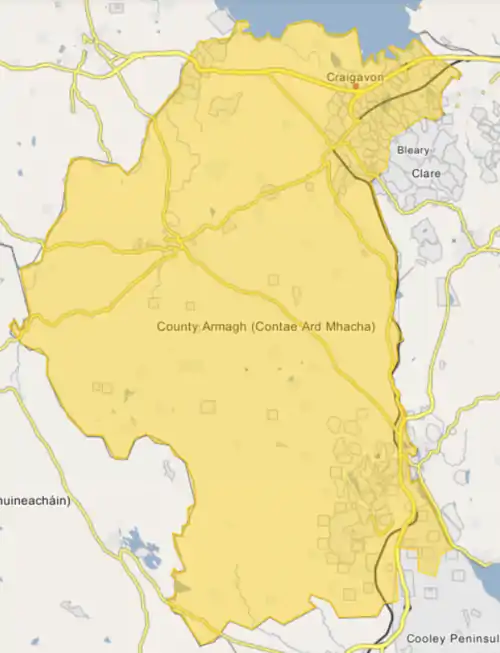
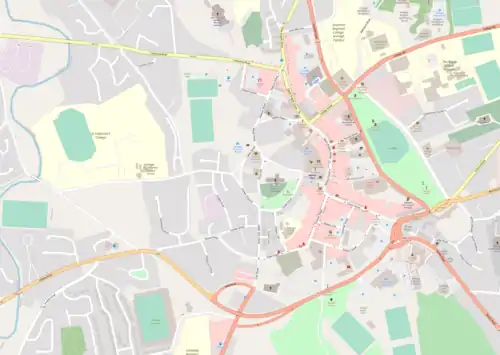
| Foundation | Image | Communities & Provenance | Formal Name or Dedication & Alternative Names | OnLine References & Location |
|---|---|---|---|---|
| Armagh Abbey | Augustinian Canons Regular founded before 1126, consecrated by Archbishop Cellach 1126; refounded 1134; Augustinian Canons Regular — Arroasian adopted c.1140 at the instigation of St Malachy; dissolved 1562; re-established |
SS Peter and Paul | [1] 54°20′58″N 6°39′22″W (approx) | |
| Armagh Blackfriars ø | suggested community of Dominican Friars purportedly founded c.1264 by Patrick O'Scanlon; evidence lacking |
|||
| Armagh Priory of Culdees | Culdees founded before 779 |
Ard-macha Altum Machae; Emain-Macha; Druim Saillech | [2] 54°20′49″N 6°39′25″W (approx) | |
| Armagh Temple-na-Ferta ?Abbey | Gaelic nuns founded 5th century by St Patrick; Augustinian Cannonesses Regular — Arroasian? apparently refounded c.1144?; dissolved 1562?; granted to Francis Annesley, Esq. by King James 1618 |
Temple Fortagh | [3][4] 54°20′49″N 6°39′07″W (approx) | |
| Armagh Temple Brigid ?Priory | Gaelic nuns dependent on Temple-na-Ferta founded 5th century by St Patrick; Augustinian Cannonesses Regular — Arroasian? apparently refounded c.1144?; dissolved 1562? |
Templebreed Priory | [5] 54°20′51″N 6°39′17″W (approx) | |
| Armagh Friary # | 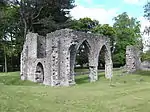 |
Franciscan Friars founded 1263/4-1551 by Archbishop Patrick O’Scannail; dissolved 1542, though some religious life continued; buildings were used for welfare purposes later in the 16th century; ruinous by 1600 |
[6] 54°20′38″N 6°39′11″W | |
| Armagh Abbey of Columcille | founded before 1010; noted as St Columba’s Church - Rocque’s 1760 map of Armagh | Templecolumkilly in Bore-netrian-sassenach | [7] 54°20′59″N 6°39′24″W (approx) | |
| Ballymoyer Monastery ≈ | early monastic site, founded by St Patrick,[notes 1] possibly Tehallan, County Monaghan[notes 2] | Baile-mac-maier; Ballymyre; Tech-talain?; Tahellen? | [8][9][10] 54°13′02″N 6°31′22″W | |
| Creggan | Franciscan Friars, First Order — place of refuge | Cregan | [11][12] 54°04′57″N 6°34′34″W (approx) | |
| Derrynoose Monastery ~ | early monastic site, founded 6th century by Mochua of Dairinis; later Culdees of Armagh also suggested to be located in County Cavan[notes 3] |
Dairinis; Derinish; Derenoyse; Toaghy | [13][14] 54°13′57″N 6°47′04″W | |
| Eglish Monastery | early monastic site; remains of two high crosses on site[notes 4] | Eglais | [15] 54°23′39″N 6°45′35″W | |
| Killevy Friary ≈¤ | Franciscan Friars, Third Order Regular actually Killeenbrenan, County Mayo — the house at Killevy being a convent of nuns |
Kilslere Friary | ||
| Killevy Abbey | 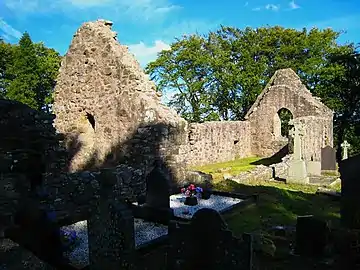 |
Gaelic nuns (community founded c.484 at Faughart; transferred to Beg-erin, County Wexford) transferred from Beg-erin: founded c.500 (517) by St Moninna (Darerca); Augustinian Cannonesses Regular — Arroasian? refounded after 1171? C.I. parish church built on site |
Cell Sleibe Cuilin; Cell-shleibe; Cell-shleibe-mor-Cuillin; Mons-Cuillinn; Kilsleve; Belslebhe; Killeavy | [16] 54°08′14″N 6°24′33″W |
| Kill-unche Monastery ~ | founded by St Nectan in reg. Conalliae Murthemhne, possibly located in County Armagh | |||
| Kilmore Monastery | early monastic site, founded by St Mochta burned 749; also identified as Kilmore, County Monaghan; Church of Ireland church built on site |
Cellmor-einer; Cellmor-muighe-emhir; Cellmor-Ua-Niallain; Cellmor-inir; Cellmor-Aedhan; Kilmore Aedhan; cell-mor; Cella Magna?; Lismor?; Killmor-Aedhan? | [17] 54°24′01″N 6°32′53″W | |
| Kilnasaggart Monastery # | site occupied by the Kilnasaggart Stone | Ternocc mac Ciarain dećc; i Cill na Saccart | [18][19] 54°04′18″N 6°22′46″W (approx) | |
| Mullaghbrack | Armagh Culdees - the Prebendary of Mullaghbrack | Mullach Breac | [20][21] 54°19′13″N 6°31′40″W | |
| Seagoe Monastery | early monastic site, founded by St Gobhan, abbot | Suidhe Gobha; Tech-da-Gobha; Tegh-da-Gobha | [22] 54°26′15″N 6°25′28″W | |
| Straidbail-Loyse Friary ≈ | given as friary of Franciscans founded 1282; probable mistaken reference to Stradbally, County Laois |
|||
| Tartaraghan | Grange of the Abbey of St. Peter and St. Paul in Armagh | [23][24][25] 54°26′59″N 6°33′12″W | ||
| Tassagh Priory | Culdees,dependent on Armagh and Derrynoose; St Tassach? Culdee cemetery |
Ballintassa; Tassaghowtragh | [26][27] 54°16′50″N 6°40′20″W | |
| Tech-fethgnai Monastery | early monastic site, possibly a cell near Armagh monastery, founded by Mael-muire, erenagh | |||
| Tynan Abbey # | Gaelic monks founded before 1072; mansion named 'Fairview' built on site c.1750; remodelled in the monastic-gothic style, residence of the Stronge family; part in use by the Royal Ulster Constabulary from 1923; bombed by the IRA 21 January 1981; demolished 1998 |
Tiudhnidha; Tuidnigha | [28] 54°19′52″N 6°49′23″W | |
Map link to lists of monastic houses in Ireland by county
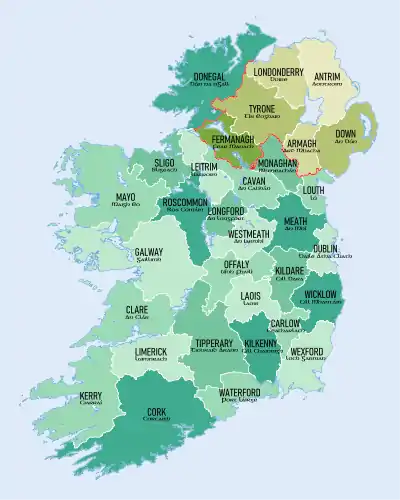 Click on a county to go to the corresponding article |
Notes
- Ballymyre identified with Tahellin — J.B. Leslie, Armagh Clergy and Parishes, 1911
- Ballymyre identified with Tehallin — G. T. Stokes and Hennessy
- Derrynoose identified with Dairinis, County Cavan — Plummer; Rev. T. Fee, communications, identifies 'in terra Ergallensium' as Derrynoose, County Armagh
- Eglish — Rev. T. Fee, communications
References
- "Ulster Journal of Archaeology, October 1897". Mocavo. Archived from the original on 19 March 2016. Retrieved 7 November 2020.
- James Stuart (1819). Historical Memoirs of the City of Armagh. A. Wilkinson. pp. 96–.
- Seán Duffy (15 January 2005). Medieval Ireland. pp. 48–. ISBN 978-1-135-94824-5.
- "Archived copy" (PDF). Archived from the original (PDF) on 29 November 2014. Retrieved 16 November 2014.CS1 maint: archived copy as title (link)
- Mervyn Archdall (1873). Monasticon Hibernicum. W. B. Kelly. pp. 49–.
- Lynn, C. J.; Simms, Katharine; Paterson, T. G. F.; Bateson, Donal; Dolley, Michael (1975). "Excavation in the Franciscan Friary Church, Armagh". Ulster Journal of Archaeology. 38: 61–80. JSTOR 20567749.
- "Archived copy". Archived from the original on 19 March 2016. Retrieved 18 November 2014.CS1 maint: archived copy as title (link)
- "Place Names NI - Home".
- Samuel Lewis (1849). A Topographical Dictionary of Ireland. S. Lewis and Company. pp. 147–.
- The Irish Ecclesiastical Record. Browne and Nolan. 1870. pp. 47–.
- ó Fiaich, Tomas (1956). "From Creggan to Louvain". Seanchas Ardmhacha: Journal of the Armagh Diocesan Historical Society. 2 (1): 90–113. doi:10.2307/29740625. JSTOR 29740625.
- http://www.uppercreggan.co.uk/historical-overview.php
- "Place Names NI - Home".
- Reeves, William (1900). "The History of Tynan Parish, in the Arch-Diocese of Armagh (Continued)". Ulster Journal of Archaeology. 6 (4): 210–217. JSTOR 20565973.
- http://blackwaterregion.com/site/wp-content/uploads/2014/10/HeritageGuide.pdf
- Killevy (Killeavy) Old Churches
- "History | Kilmore Parish, Armagh".
- "Place Names NI - Home".
- Andy O`Halpin; Conor Newman (26 October 2006). Ireland. OUP Oxford. pp. 108–. ISBN 978-0-19-151317-6.
- "Place Names NI - Home".
- McGleenon, C. F. (1987). "The Medieval Parishes of Ballymore and Mullabrack". Seanchas Ardmhacha: Journal of the Armagh Diocesan Historical Society. 12 (2): 11–54. doi:10.2307/29745259. JSTOR 29745259.
- http://www.lisburn.com/books/dromore-diocese/parish-seagoe.html
- "Tartaraghan Precinct".
- "Archived copy". Archived from the original on 24 September 2015. Retrieved 10 February 2015.CS1 maint: archived copy as title (link)
- "Archived copy". Archived from the original on 30 August 2011. Retrieved 31 December 2009.CS1 maint: archived copy as title (link)
- "Place Names NI - Home".
- Noreen Cunningham; Pat McGinn (2001). The Gap of the North: The Archaeology & Folklore of Armagh, Down, Louth, and Monaghan. O'Brien Press. ISBN 978-0-86278-707-3.
- "Ulster journal of archaeology". Belfast [Ulster Archaeological Society].